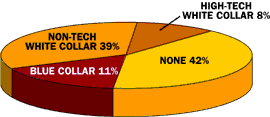Motivation to Practice Mindfulness
Read this excerpt from "Coming to Our Senses" about the importance of mindfulness and living in the moment.
Why Even Bother with Mindfulness?
If, from the meditative perspective, everything you are seeking is already here, even if it is difficult to wrap your thinking mind around that concept, if there really is no need to acquire anything or attain anything or improve yourself, if you are already whole and complete and by that same virtue so is the world, then why on earth bother meditating? Why would we want to cultivate mindfulness in the first place? And why use particular methods and techniques, if they are all in the service of not getting anywhere anyway, and when, moreover, I've just finished saying that methods and techniques are not the whole of it anyway?
The answer is that as long as the meaning of "everything you are seeking is already here" is only a concept, it is only a concept, just another nice thought. Being merely a thought, it is extremely limited in its capacity for transforming you, for manifesting the truth the statement is pointing to, and ultimately changing the way you carry yourself and act in the world.
More than anything else, I have come to see meditation as an act of love, an inward gesture of benevolence and kindness toward ourselves and toward others, a gesture of the heart that recognizes our perfection even in our obvious imperfection, with all our shortcomings, our wounds, our attachments, our vexations, and our persistent habits of unawareness. It is a very brave gesture: to take one's seat for a time and drop in on the present moment without adornment. In stopping, looking, and listening, in giving ourselves over to all our senses, including mind, in any moment, we are in that moment embodying what we hold most sacred in life. Making the gesture, which might include assuming a specific posture for formal meditation, but could also involve simply becoming more mindful or more forgiving of ourselves, immediately re-minds us and re-bodies us. In a sense, you could say that it refreshes us, makes this moment fresh, timeless, freed up, wide open. In such moments, we transcend who we think we are. We go beyond our stories and all our incessant thinking, however deep and important it sometimes is, and reside in the seeing of what is here to be seen and the direct, non-conceptual knowing of what is here to be known, which we don't have to seek because it is already and always here. We rest in awareness, in the knowing itself which includes, of course, not knowing as well. We become the knowing and the not knowing, as we shall see over and over again. And since we are completely embedded in the warp and woof of the universe, there is really no boundary this benevolent gesture of awareness, no separation from other beings, no limit to either heart or mind, no limit to our being or our awareness, or to our openhearted presence. In words, it may sound like an idealization. Experienced, it is merely what it is, life expressing itself, sentience quivering within infinity, with things just as they are.
Resting in awareness in any moment involves giving ourselves over to all our senses, in touch with inner and outer landscapes as one seamless whole, and thus in touch with all of life unfolding in its fullness in any moment and in every place we might possibly find ourselves, inwardly or outwardly.
Thich Nhat Hanh, the Vietnamese Zen master, mindfulness teacher, poet, and peace activist, aptly points out that one reason we might want to practice mindfulness is that most of the time we are unwittingly practicing its opposite. Every time we get angry we get better at being angry and reinforce the anger habit. When it is really bad, we say we see red, which means we don't see accurately what is happening at all, and so, in that moment, you could say we have "lost" our mind. Every time we become self-absorbed, we get better at becoming self-absorbed and going unconscious. Every time we get anxious, we get better at being anxious. Practice does make perfect. Without awareness of anger or of self-absorption, or ennui, or any other mind state that can take us over when it arises, we reinforce those synaptic networks within the nervous system that underlie our conditioned behaviors and mindless habits, and from which it becomes increasingly difficult to disentangle ourselves, if we are even aware of what is happening at all. Every moment in which we are caught, by desire, by an emotion, by an unexamined impulse, idea, or opinion, in a very real way we are instantly imprisoned by the contraction within the habitual way we react, whether it is a habit of withdrawal and distancing ourselves, as in depression and sadness, or erupting and getting emotionally "hijacked" by our feelings when we fall headlong into anxiety or anger. Such moments are always accompanied by a contraction in both the mind and the body.
But, and this is a huge "but," there is simultaneously a potential opening available here as well, a chance not to fall into the contraction -- or to recover more quickly from it -- if we can bring awareness to it. For we are locked up in the automaticity of our reaction and caught in its downstream consequences (i.e., what happens in the very next moment, in the world and in ourselves) only by our blindness in that moment. Dispel the blindness, and we see that the cage we thought we were caught in is already open.
Every time we are able to know a desire as desire, anger as anger, a habit as habit, an opinion as an opinion, a thought as a thought, a mind-spasm as a mind-spasm, or an intense sensation in the body as an intense sensation, we are correspondingly liberated. Nothing else has to happen. We don't even have to give up the desire or whatever it is. To see it and know it as desire, as whatever it is, is enough. In any given moment, we are either practicing mindfulness or, de facto, we are practicing mindlessness. When framed this way, we might want to take more responsibility for how we meet the world, inwardly and outwardly in any and every moment -- especially given that there just aren't any "in-between moments" in our lives.
So meditation is both nothing at all -- because there is no place to go and nothing to do -- and simultaneously the hardest work in the world -- because our mindlessness habit is so strongly developed and resistant to being seen and dismantled through our awareness. And it does require method and technique and effort to develop and refine our capacity for awareness so that it can tame the unruly qualities of the mind that make it at times so opaque and insensate.
These features of meditation, both as nothing at all and as the hardest work in the world, necessitate a high degree of motivation to practice being utterly present without attachment or identification. But who wants to do the hardest work in the world when you are already overwhelmed with more things to do than you can possibly get done -- important things, necessary things, things you may be very attached to so you can build whatever it is that you may be trying to build, or get wherever it is that you are trying to get to, or even sometimes, just so you can get things over with and check them off your to-do list? And why meditate when it doesn't involve doing anyway, and when the result of all the non-doing is never to get anywhere but to be where you already are? What would I have to show for all my non-efforts, which nevertheless take so much time and energy and attention?
All I can say in response is that everybody I have ever met who has gotten into the practice of mindfulness and has found some way or other to sustain it in their lives for a period of time has expressed the feeling to me at one point or another, usually when things are at their absolute worst, that they couldn't imagine what they would have done without the practice. It is that simple really. And that deep. Once you practice, you know what they mean. If you don't practice, there is no way to know.
And of course, probably most people are first drawn to the practice of mindfulness because of stress or pain of one kind or another and their dissatisfaction with elements of their lives that they somehow sense might be set right through the gentle ministrations of direct observation, and self-compassion. Stress and pain thus become potentially valuable portals and motivators through which to enter the practice.
And one more thing. When I say that meditation is the hardest work in the world, that is not quite accurate, unless you understand that I don't just mean "work" in the usual sense, but also as play. Meditation is playful too. It is hilarious to watch the workings of our own mind, for one thing. And it is much too serious to take too seriously. Humor and playfulness, and undermining any hint of a pious attitude, are critical to right mindfulness. And besides, maybe parenting is the hardest work in the world. But, if you are a parent, are they two different things?
I recently got a call from a physician colleague in his late forties who had undergone hip replacement surgery, surprising for his age, for which he needed an MRI before the operation took place. He recounted how useful the breath wound up being when he was swallowed by the machine. He said he couldn't even imagine what it would be like for a patient who didn't know about mindfulness and using the breath to stay grounded in such a difficult situation, although it happens every single day.
He also said that he was astonished by the degree of mindlessness that characterized many aspects of his hospital stay. He felt successively stripped of his status as a physician, and a rather prominent one at that, and then of his personhood and identity. He had been a recipient of "medical care," but on the whole, that care had hardly been caring. Caring requires empathy and mindfulness, and openhearted presence, often surprisingly lacking where one would think it would be most in evidence. After all, we do call it health care. It is staggering, shocking, and saddening that such stories are even now all too common, and that they come even from doctors themselves when they become patients and need care themselves.
Beyond the ubiquity of stress and pain operating in my own life, my motivation to practice mindfulness is fairly simple: Each moment missed is a moment unlived. Each moment missed makes it more likely I will miss the next moment, and live through it cloaked in mindless habits of automaticity of thinking, feeling, and doing rather than living in, out of, and through awareness. I see it happen over and over again. Thinking in the service of awareness is heaven. Thinking in the absence of awareness can be hell. For mindlessness is not simply innocent or insensitive, quaint or clueless. Much of the time it is actively harmful, wittingly or unwittingly, both to oneself and to the others with whom we come in contact or share our lives. Besides, life is overwhelmingly interesting, revealing, and awe-provoking when we show up for it wholeheartedly and pay attention to the particulars.
If we sum up all the missed moments, inattention can actually consume our whole life and color virtually everything we do and every choice we make or fail to make. Is this what we are living for, to miss and therefore misconstrue our very lives? I prefer going into the adventure every day with my eyes open, paying attention to what is most important, even if I keep getting confronted, at times, with the feebleness of my efforts (when I think they are "mine") and the tenacity of my most deeply ingrained and robotic habits (when I think they are "mine"). I find it useful to meet each moment freshly, as a new beginning, to keep returning to an awareness of now over and over again, and let a gentle but firm perseverance stemming from the discipline of the practice keep me at least somewhat open to whatever is arising and behold it, apprehend it, look deeply into it, and learn whatever it might be possible to learn as the nature of the situation is revealed in the attending.
When you come right down to it, what else is there to do? If we are not grounded in our being, if we are not grounded in wakefulness, are we not actually missing out on the gift of our very lives and the opportunity to be of any real benefit to others?
It does help if I remind myself to ask my heart from time to time what is most important right now, in this moment, and listen very carefully for the response.
As Thoreau put it at the end of Walden, "Only that day dawns to which we are awake."
Copyright © 2005 Jon Kabat-Zinn, Ph.D.
Excerpted from the book: Coming to Our Senses: Healing Ourselves and the World Through Mindfulness by Jon Kabat-Zinn. Copyright © 2005 Jon Kabat-Zinn, Ph.D. (Published by Hyperion; January 2005; $24.95US/$34.95CAN; 0-7868-6756-6)
About the author: Jon Kabat-Zinn, Ph.D., is the founding director of the Stress Reduction Clinic and the Center for Mindfulness in Medicine, Health Care, and Society at the University of Massachusetts Medical School, as well as Professor of Medicine emeritus. He leads workshops on stress reduction and mindfulness for doctors and other health professionals and for lay audiences worldwide. He is the bestselling author of Wherever You Go, There You Are and Full Catastrophe Living, and, with his wife, Myla Kabat-Zinn, of a book on mindful parenting, Everyday Blessings. He was featured in the PBS series Healing and the Mind with Bill Moyers, as well as on Oprah. He lives in Massachusetts.
For more information, please visit www.writtenvoices.com.
APA Reference
Staff, H.
(2008, December 24). Motivation to Practice Mindfulness, HealthyPlace. Retrieved
on 2026, January 9 from https://www.healthyplace.com/alternative-mental-health/sageplace/motivation-to-practice-mindfulness
 How To Help Someone Who's Depressed
How To Help Someone Who's Depressed Since the 1960s, the number of cases of eating disorders has doubled in the United States, according to the Eating Disorders Coalition, a non-profit advocacy organization. About 0.5 percent of teenage girls suffer from anorexia. Up to 5 percent have bulimia nervosa, in which they binge on food and then purge by vomiting or using laxatives, according to the Chicago-based American Academy of Pediatrics.
Since the 1960s, the number of cases of eating disorders has doubled in the United States, according to the Eating Disorders Coalition, a non-profit advocacy organization. About 0.5 percent of teenage girls suffer from anorexia. Up to 5 percent have bulimia nervosa, in which they binge on food and then purge by vomiting or using laxatives, according to the Chicago-based American Academy of Pediatrics.
 a balm for wounds, burns, and insect bites.
a balm for wounds, burns, and insect bites.


